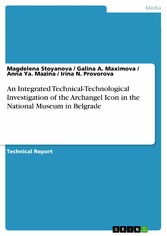Search and Find
Service
An Integrated Technical-Technological Investigation of the Archangel Icon in the National Museum in Belgrade
More of the content

An Integrated Technical-Technological Investigation of the Archangel Icon in the National Museum in Belgrade
Technical Report from the year 2016 in the subject Art - Overall Considerations, grade: A COST Case Study, , course: Cost Action TD1201 Working Group Meetings; 5th international Culture Forum St. Peterburg December 2016, language: English, abstract: This complex investigation by European and Russian experts was carried out for the purpose of solving the question of the authorship and date of the Archangel icon kept in the National Museum in Belgrade and attributed to the 15th c Novgorod school. It had also the task to explore the possibilities and limits of non-destructive methods in identification, dating and authentication of icon painting, as well as of other types of historic easel painting. In addition to the various technological methods, the research project included assessment of the outcomes on base of additional information from databases accumulated by leading research and restoration centers in Russia and Eastern Europe. The authors' purpose was to demonstrate that actually the conditions for authenticity controls are easily available, and that they can be realized at an enough competitively level, making better use of already accumulated experience and using a more common technological base. Particularly important is to underline that tools for efficient non-contact investigation of artefacts are not exclusively the optical techniques and the utilized instruments for themselves, but also the way in which the various data they produce have been assessed. For to transform these informational resources in real knowledge, their mass storage and interactive art historical, technical and technological assessment is of fundamental importance. The non-destructive methods and techniques used included optical microscopy, macro photography in VIS/raking light, stereo microscopy, ultraviolet luminescence/fluorescence, infrared reflectography, X-ray, EDXRFS, computer tomography, anatomical analysis of wood, micro chemical analysis, and were followed by a comparison and post processing of obtained data and images, allowing to date the icon at the second half of the 19th century (the earlier attribution was 15th century). The icon may have been created by icon painters of the southern regions of the Russian Empire (perhaps in Moldova or Ukraine). The results created the conditions for a detailed mapping of its status of conservation and were indispensable for to understand the origin of the damages.
1989: PhD in Byzantine and post Byzantine art history awarded by the University Paris-I Panthéon-Sorbonne/INALCO. 1983-6: PhD fellowship /scientific researcher in Medieval Art History of the Balkans at the Bulgarian Academy of Sciences. 1982: M.Sc degree in art history from the Academy of Fine Arts - Sofia. Author of three books and 25 publications on orthodox cultural heritage in Russian, French, German, Italian, English and Bulgarian, and of 27 on modern art and industrial design in Bulgarian: http://abilitazione.miur.it/public/viewCvcandidato.php?id_dom=54787 Conferences on the iconographical schools and collections of orthodox art. Lecturer at professional training courses on historic techniques and materials in oriental painting and gilding. Collaboration for the restoration of important Byzantine mosaics, of wall and easel paintings, furniture, Venetian lacquers, casein tempera ceilings, silver covers. Hundreds of expertises on eastern European ancient and modern artefacts. Top market achievement: £ 3 milliards (Venice 1999) for 16 icons by T. Poulakis Field research on the Levantine and Alpine flora on 'Useful plant resources in crafts and industry'. Comments to written sources on chemistry of ancient inks, tanned leather, dyed and printed textiles. Reconstruction of ancient technical recipes and development of materials of plant origin for arts&craft techniques, conservation and restoration: pigments, varnishes, lacquers, adhesives, inks, surface-active agents, solvents, biocides, impregnation and consolidation substances for mortars and paintings on different supports, for conservation of historic textiles, gildings and of gilt leather. Research on the emulsion stabilizers and natural pigments used in Europe and Africa (Ethiopia and Somalia particularly). Hundreds of works realized in varieties of tempera; in encaustic and casein painting; in emulsions, oil or in mixed techniques on different supports. Designs. Lacquers. Paintings and prints on silk. Authentic art copies. Design and realization of furniture. Conservation and restoration of glass, paper, textiles, silver, mosaics, leather. Art expert by the Commercial Chambre and the Court of Venice. Member of CISBI - Ca' Foscari (Venice). Network with COST/COSCH, Art-Conservation.Ru, Orbis Aethiopicus, etc. Awarded the art-con.ru ( 'Best Investigation in Conservation and Restoration (??????????????? ???????)' Prize for the year 2012, http://art-con.ru/node/1469
All prices incl. VAT











